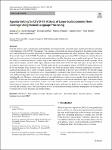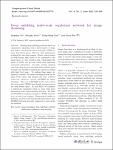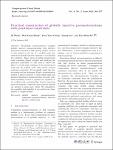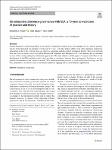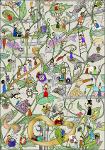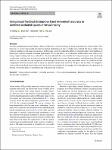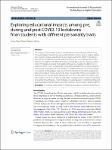Search
Author
- Jorgensen, Ed (3)
- McFadyen, Ron (3)
- Nora, El-Rashidy (3)
- Christian, Homeyer (2)
- next >
Subject
- programming (10)
- Open Access (8)
- Java (7)
- Programming (7)
- next >
Date issued
- 2020 - 2025 (293)
- 2010 - 2019 (39)
- 2000 - 2009 (2)
- 1999 - 1999 (1)
Has File(s)
- true (335)
Search Results
Over the past two years, organizations and businesses have been forced to constantly adapt and develop effective responses to the challenges of the COVID-19 pandemic. The acuteness, global scale and intense dynamism of the situation make online news and information even more important for making informed management and policy decisions. This paper focuses on the economic impact of the COVID-19 pandemic, using natural language processing (NLP) techniques to examine the news media as the main source of information and agenda-setters of public discourse over an eight-month period. |
Existing deep unfolding methods unroll an optimization algorithm with a fixed number of steps, and utilize convolutional neural networks (CNNs) to learn data-driven priors. However, their performance is limited for two main reasons. Firstly, priors learned in deep feature space need to be converted to the image space at each iteration step, which limits the depth of CNNs and prevents CNNs from exploiting contextual information. Secondly, existing methods only learn deep priors at the single full-resolution scale, so ignore the benefits of multi-scale context in dealing with high level noise. To address these issues, we explicitly consider the image denoising process in the deep feature space and propose the deep unfolding multi-scale regularizer network (DUMRN) for image denoising |
To be effective, data-intensive systems require extensive ongoing customisation to reflect changing user requirements, organisational policies, and the structure and interpretation of the data they hold. Manual customisation is expensive, time-consuming, and error-prone. In large complex systems, the value of the data can be such that exhaustive testing is necessary before any new feature can be added to the existing design. In most cases, the precise details of requirements, policies and data will change during the lifetime of the system, forcing a choice between expensive modification and continued operation with an inefficient design.Engineering Agile Big-Data Systems outlines an approach to dealing with these problems in software and data engineering, describing a methodology fo... |
The chapters in this open access book arise out of the EU Cost Action project Cryptacus, the objective of which was to improve and adapt existent cryptanalysis methodologies and tools to the ubiquitous computing framework. The cryptanalysis implemented lies along four axes: cryptographic models, cryptanalysis of building blocks, hardware and software security engineering, and security assessment of real-world systems.
The authors are top-class researchers in security and cryptography, and the contributions are of value to researchers and practitioners in these domains. |
We propose a novel method to compute globally injective parameterizations with arbitrary positional constraints on disk topology meshes. Central to this method is the use of a scaffold mesh that reduces the globally injective constraint to a locally flipfree condition. Hence, given an initial parameterized mesh containing flipped triangles and satisfying the positional constraints, we only need to remove the flips of a overall mesh consisting of the parameterized mesh and the scaffold mesh while always meeting positional constraints. To successfully apply this idea, we develop two key techniques. |
General Enterprise Architecting (GEA) is an enterprise architecture method which has emerged out of a need in practice, and has been developed and matured over the past 15 years. The GEA method differs from other enterprise architecture approaches in that it has a strong focus on enterprise coherence and the explicit governance thereof. This focus followed from the observed need to move beyond the Business-IT alignment and ‘Business-to-IT’ stack thinking that is embodied in most of the existing enterprise architecture approaches. The main objective of this paper is to report, and reflect on, the development of the GEA method (so-far), which involved a co-evolution between theory and practice. |
"This book discusses what is currently known about software engineering, based on an analysis of all the publicly available data. This aim is not as ambitious as it sounds, because there is not a great deal of data publicly available.
The intent is to provide material that is useful to professional developers working in industry; until recently researchers in software engineering have been more interested in vanity work, promoted by ego and bluster.
The material is organized in two parts, the first covering software engineering and the second the statistics likely to be needed for the analysis of software engineering data." |
With the explosive growth of artificial intelligence (AI) and big data, it has become vitally important to organize and represent the enormous volume of knowledge appropriately. As graph data, knowledge graphs accumulate and convey knowledge of the real world. It has been well-recognized that knowledge graphs effectively represent complex information; hence, they rapidly gain the attention of academia and industry in recent years. Thus to develop a deeper understanding of knowledge graphs, this paper presents a systematic overview of this field. Specifically, we focus on the opportunities and challenges of knowledge graphs. We first review the opportunities of knowledge graphs in terms of two aspects: (1) AI systems built upon knowledge graphs; (2) potential application fields of kn... |
Accurate and informative hand-object collision feedback is of vital importance for hand manipulation in virtual reality (VR). However, to our best knowledge, the hand movement performance in fully-occluded and confined VR spaces under visual collision feedback is still under investigation. In this paper, we firstly studied the effects of several popular visual feedback of hand-object collision on hand movement performance. To test the effects, we conducted a within-subject user study (n=18) using a target-reaching task in a confined box. Results indicated that users had the best task performance with see-through visualization, and the most accurate movement with the hybrid of proximity-based gradation and deformation. |
The influence of personality traits on educational outcomes has been widely recognized and studied. Research has explored its effects on factors such as student satisfaction, academic anxiety, and dishonesty, particularly during the COVID-19 pandemic. However, there has been a lack of studies comparing the learning behaviors and performance of students with different personality traits during the pre, during, and post-COVID-19 lockdown periods. This study fills this gap by analyzing the differences in academic metrics, such as class grades and assignment submissions, among students with varying personality traits during different lockdown periods. Our research, based on a dataset of 282 graduate students in the USA, identified correlations and patterns between lockdown periods, pers... |

